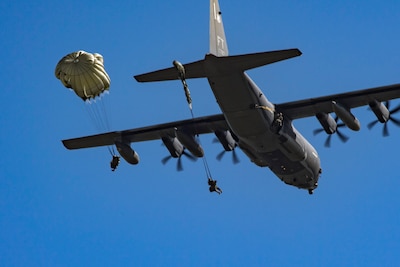By Air Force Airman 1st Class Daniel Snider 23rd Wing
MOODY AIR FORCE BASE, Ga., Oct. 17, 2017 — A member of the
820th Base Defense Group here earned his senior-rated parachutist badge,
joining the ranks of the Air Force's experienced jumpmasters Oct. 3, at the Lee
Fulp drop zone in Tifton, Georgia.
Air Force Tech. Sgt. Joe Ostrum, 820th Combat Operations
Squadron personal parachute program manager, completed the final requirement to
obtain a senior rating by fulfilling jumpmaster duties during a static-line
jump.
"Senior and master-rated jumpmasters bring an
experience level that reduces risks," said Air Force Senior Master Sgt.
David Brown, 823rd Base Defense Squadron operations superintendent and
senior–rated parachutist. "You want those guys on the aircraft overseeing
things."
To earn the star that designates a senior-rated parachutist,
airmen must conduct 30 jumps, including two during darkness, 15 with
operational equipment, one night jump as the primary jumpmaster and seven total
jumpmaster duties.
"You can't always tell a brand-new jumpmaster from any
other jumper because the badge is the same," Brown said. "If you're a
commander, you may sit back and say, 'Well, OK, I trust you. Let's see what
you've got.' But if they're senior-rated, you may feel more comfortable because
the person has more experience and gives a little more confidence that they
have the expertise to give the best recommendation."
Credibility
So not only does the senior-rating badge display experience
at home station, but also in joint operations. Brown added that within the
Army, credibility is worn on the uniform in the form of badges signifying
qualifications.
"I went to Afghanistan and we were doing
outside-the-wire missions," Ostrum said. "The Army owned the battle
space, and they looked at us and said, 'Why's the Air Force going outside the
wire?' So they started canceling our missions. So I made a brief for [their
commander] about what schools are offered to the 820th [Base Defense Group] --
what schools we've graduated and use on a daily basis.
"I told him I had been through basic Airborne, and that
I was a jumpmaster and a few other courses and right then, his attitude
changed," he continued. "It's just one of those things that helps us
conduct the mission in a joint environment and builds the credibility."
In addition to strengthening cohesiveness within the joint
environment, the senior rating assists in putting newer jumpers at ease.
Minimizing Risk
"Jumping out of an aircraft is inherently scary for
many people, but it's a risk because people can be seriously hurt," Brown
said. "So, we owe it to the taxpayers to minimize risk, and we do that
with experience and rules. We scrutinize the program and have experienced
personnel who [manage] the risky program."
Ostrum echoed the fact that while he may be the one wearing
the badge, what it signifies is for everyone else, too.
"There are a lot of people who looked out for me,"
he said. "It's for my mentors, and it just kind of instills the confidence
in all the jumpers and makes everybody else calmer."
While this accomplishment earned him the badge and credibility
to join the ranks of more experienced jumpmasters, Ostrum said he still looks
to work toward becoming a master-rated jumpmaster. To earn the master-rated
parachutist badge, he will need to conduct 65 jumps, including four during
darkness, 25 jumps with operational equipment, two night jumps as the primary
jumpmaster and 15 total jumpmaster duties.








No comments:
Post a Comment